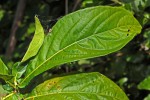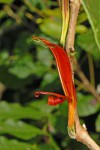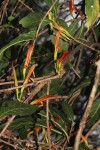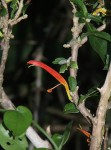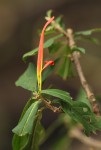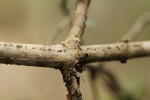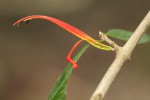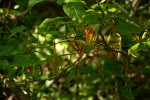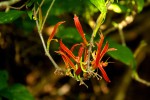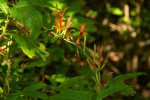Anisotes sessiliflorus
Selected images: Click on each image to see a larger version and details of the record View all images (12)
Photo: Olivier Maurin
Nhambita, edge of Gwasha, 1.45 km N of the Pungwe river, measuring from 400 m W of the point in river closest to the Old cotton factory.
Photo: Olivier Maurin
Nhambita, edge of Gwasha, 1.45 km N of the Pungwe river, measuring from 400 m W of the point in river closest to the Old cotton factory.
Detailed records: Display species records QDS maps by: Google Maps Point records by Google Maps
Species details: Click on each item to see an explanation of that item (Note: opens a new window)
| Synonyms: |
Anisotus sessiliflorus subsp. iringensis Baden Himantochilus sessiliflorus T. Anderson |
| Common names: | |
| Frequency: | |
| Status: | Native |
| Description: |
Shrub, to 3 m tall. Young branches ± 4-angled and longitudinally ridged, pale yellowish brown, older branches (dark) grey to purplish grey. Leaves 6-15 × 3-6 cm, ovate to elliptic, apex somewhat tapering to a point or rounded, base prolonged down the axis; petiole absent or ill defined to 2 mm long. Flowers in clusters of 1-3, axillary, sessile; bracts 2-2.5 mm long. Corolla tube yellow, orange to bright red, glandular hairy and with long soft hairs; 2-lipped; tube shorter than the lips. |
| Type location: |
|
| Notes: | Differs from A. rogersii by having bigger leaves and smaller bracts. |
| Derivation of specific name: | |
| Habitat: | In mopane woodland, bushland and dry riverine scrub. |
| Altitude range: (metres) | Up to 300 m |
| Flowering time: | |
| Worldwide distribution: | |
| FZ divisions: | S |
| Growth form(s): | |
| Endemic status: | |
| Red data list status: | |
| Insects associated with this species: | |
| Spot characters: | Display spot characters for this species |
| Images last updated: | Friday 13 February 2015 |
| Literature: |
Darbyshire, I., Vollesen, K. & Kelbessa, E. (2015). Acanthaceae (Part 2) Flora Zambesiaca 8(6) Page 237. Drummond, R.B. (1975). A list of trees, shrubs and woody climbers indigenous or naturalised in Rhodesia. Kirkia 10(1) Page 274. |
Other sources of information about Anisotes sessiliflorus:
Our websites:
Flora of Malawi: Anisotes sessiliflorusFlora of Mozambique: Anisotes sessiliflorus
External websites:
African Plants: A Photo Guide (Senckenberg): Anisotes sessiliflorusAfrican Plant Database: Anisotes sessiliflorus
BHL (Biodiversity Heritage Library): Anisotes sessiliflorus
EOL (Encyclopedia of Life): Anisotes sessiliflorus
GBIF (Global Biodiversity Information Facility): Anisotes sessiliflorus
Google: Web - Images - Scholar
iNaturalist: Anisotes sessiliflorus
IPNI (International Plant Names Index): Anisotes sessiliflorus
JSTOR Plant Science: Anisotes sessiliflorus
Mansfeld World Database of Agricultural and Horticultural Crops: Anisotes sessiliflorus
Plants of the World Online: Anisotes sessiliflorus
Tropicos: Anisotes sessiliflorus
Wikipedia: Anisotes sessiliflorus
